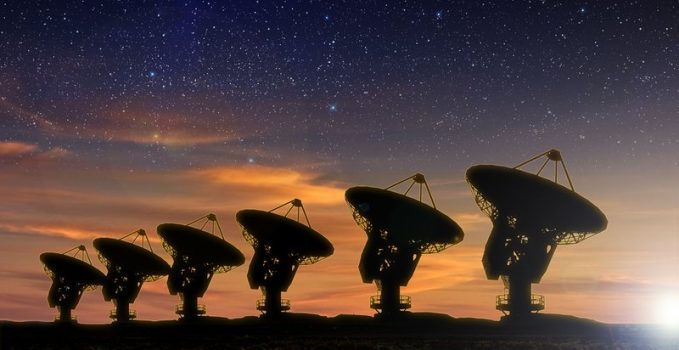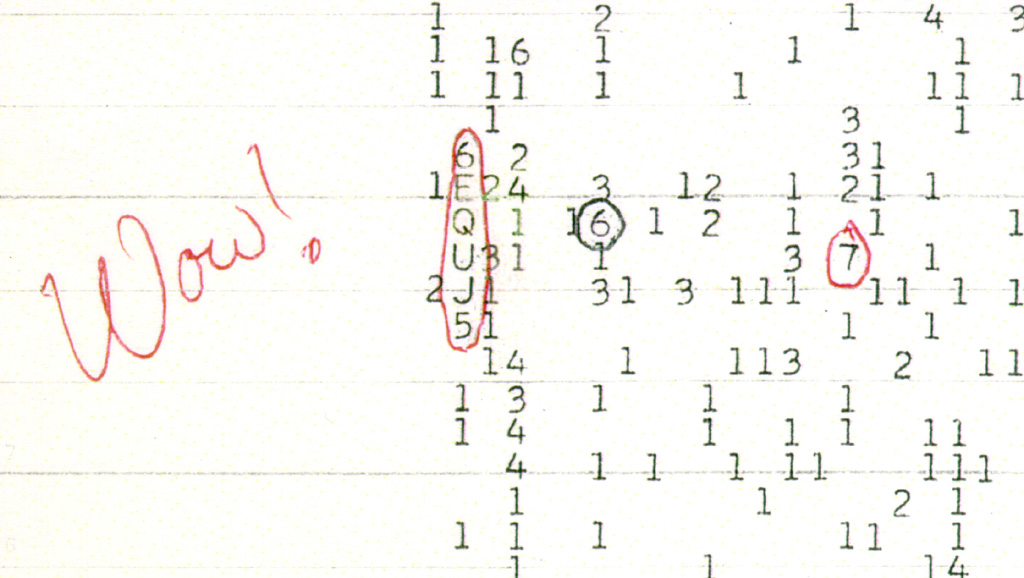It’s the question that man has asked himself since the dawn of time. Is there life out there? Green men walking around, or at least some form of life on a distant planet? Let’s take a look at why we haven’t found any extraterrestrial life yet, and how big the chances are we’re going to find it.
If you’ve ever looked outside on a bright night, you probably wondered about that age old question at least once: is there someone out there, perhaps at this very moment looking at me? Obviously, you’re not the first to ask that question. Since the first times the stars and planets were used for astronomy, man has thought about what would be out there. No matter that initially, these stars were seen as deity’s rather than E.T…
Searching for Extra Terrestrials using an Institute
In the 70s, a team of astronomers lead by the famous Carl Sagan started SETI, an institute for the ‘Search of ExtraTerrestrial Intelligence’. SETI is a loose collective of researchers using massive telescopes to listen for signals coming from space. You might know the antennas in the photo above this article.
What to listen to?
The problem with SETI is that the astronomers are not sure what to look for. They mostly look for radio and microwaves, hoping that E.T. might use that medium to send us a message, since that’s what we use to communicate ourselves, but what sort of message would ‘they’ send? Language is not the same, and even the concept of communication might be entirely different for other creatures from different worlds. Scientists are mostly looking for anything that’s out of the ordinary, and in 1972, they almost did.
Wow!
As a SETI-telescope was listening, it caught an anomaly in radio waves coming from a certain direction that looked very different when put into coordinates – so different, in fact, the scientist that discovered it wrote ‘Wow!’ in red pen on his sheet with numbers. Ever since, this anomaly has been known as the ‘Wow!-signal’, and scientists have tried listening for exactly the same thing in exactly the same spot – but so far, we haven’t really heard back. It’s still not entirely sure what the Wow!-signal was, though every once in a while a theory comes up that is just as soon shot down again by other scientists. We’re still looking and listening for E.T., but haven’t found them yet.
Crisps in space
There’s also a fierce debate going on about whether we should only listen for messages from aliens, or perhaps send our own ‘Hello universe’ out there as well. This process is called METI, or ‘Messaging Extra Terrestrial Intelligence’, and it became an especially hard discussion in the early days of SETI. Eventually, it turned out there was no legal framework that could stop anyone from sending messages to space, so despite much criticism some scientists did just that. Later, the messages went from pretty universal and quite simple in nature to less serious ones. At one point, there was even a Dorito’s commercial broadcast to the skies, much to the annoyance of a lot of people.
To this day, we’re sending out radio signals to the stars. Those signals aren’t even the ones we consciously broadcast, but also a lot of signals from tv’s, satellites and mobile phones. The question is: who’s out there to hear it?
Statistics
You don’t need to wear a tinfoil hat to believe in E.T. According to a lot of experts, the statistical probability of any planet in the universe developing intelligent life is almost 100%. Look at how many stars there are – our Milky Way alone has somewhere between 100 billion and 400 billion stars, depending on who you ask and how you measure it. There’s easily a couple of billion Milky Ways out there, and since we now know that a lot of those stars in those galaxies have planets, that’s lot of potential life.
Habitable zones
Of course, scientists look for more prerequisites for life. They study the atmosphere of planets for oxygen, the surface for liquid water, and they look if the planet is in the habitable zone around a star. But the only reason we look at these traits to find life is simply because that’s the only life we know now. All life is Earth is carbon based, needs certain temperatures to live, and breathes oxygen. We need to assume extraterrestrial life is the same, not because we think it, but because the alternative means we wouldn’t know where to even start looking.
Composites of life
This is the reason why, in 2012, scientists were excited when several specimens were discovered that had DNA composed of arsenic. It was the first irrefutable evidence that life does not necessarily have to have all the same components. If arsenic-based lifeforms could exist, then why wouldn’t there be life that could live without water, or oxygen, or in extreme temperatures?
Unfortunately, the enthusiasm quickly diminished after it was discovered the scientists made errors during the collection of the samples. They were contaminated with molecules that came from the very place they were found. So far, all life we know is pretty much the same – so we know what we’re looking for.
Pointing telescopes
Scientists are still looking for planets similar to Earth, and it’s actually not very long ago that we found them first. Astronomers have always expected that exoplanets (meaning planets that are not in our solar system) exist, but the first time such a planet was discovered was only 25 years ago. In 1992, a pulsar was discovered with two stars orbiting around it.
After only 25 years, the number of exoplanets discovered is still rising exponentially and currently sits at almost 3500. Most interesting are periodic discoveries of exoplanets that are often dubbed ‘second Earths‘, a qualification that can based on a lot of things such as the size of the planet, its proximity to its star (more specifically, when it’s in the habitable zone), or the composition of either the planet or its atmosphere.
Where are they?
So the chances of finding extraterrestrial life are increasing every day, which begs the question: why haven’t we found it yet? That paradox is what Enrico Fermi thought about – so much so that he named his train of thought the <strong.Fermi Paradox.
Paradoxal
Fermi’s paradox states that if we assume that extraterrestrial life exists, we should have made contact by now, and the fact that we haven’t can mean a few things.
The most obvious one is that we are, indeed, completely alone. It would mean there’s no paradox because we are really the only planet out of trillions and trillions were life has popped up. A lonely thought, surely, but still a possibility.
Wiping out
The other options aren’t much more cheerful. One possible explanation is that there has been intelligent life at some point, but it has eventually wiped itself out before it got too advanced to learn interstellar travel or at least communication. It’s not unthinkable – just like the origins of life, all societies in history have gone under in one way or another, and only a few decades ago we again came pretty close to selfdestruction with the nuclear arms race. So it might just be that we have gotten either lucky or really good and cleared the hurdle that has destroyed many other extraterrestrial civilizations.
The third option is the most depressing one. We might to resign ourselves to the fact that it’s simply impossible to get in touch with whoever is out there.
Cosmic scales
That’s not a farfetched thought, looking at the size of the universe. Even the nearest star to us (Proxima Centauri B) would take 4 years to reach with the speed of light. Since the laws of physics prohibit anything traveling faster than light, it’d take at least that time for a simple radio message to reach our planet. Other stars are many thousands or even millions of lightyears away. It could be possible that any existing civilizations have send out messages so long ago that they haven’t even reached us yet.
Small probability
The probability of us intercepting any such message is so minuscule, even more so because humans have only been around for some 300.000 years at the most liberal estimate, and 10.000 at the most conservative. And of those years, we’ve only been actively listening to the skies for 30 of them.
Most likely, we’re not going to find life outside our own planet for a while. There are so many factors that have to come together perfectly, which all operate within a very thin margin, that it would be a massive coincidence to find anything that could be intelligent life. It would mean aliens have to live in approximately the same time scale as we do, preferably not be too far away, using signals we both can receive and understand, pointed at exactly our planet… It might be just a bit too much to ask. But that doesn’t mean we should give up. The truth, and the aliens, could be out there!
Tags : achtergrond, aliens, astronomie, et, meti, ruimtevaart, SETI




